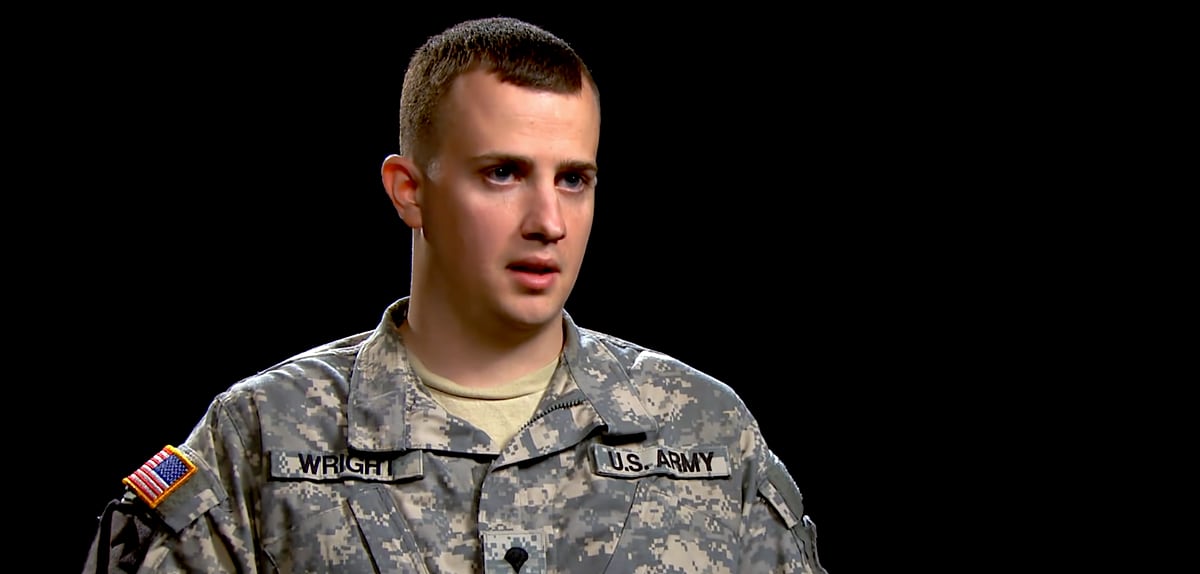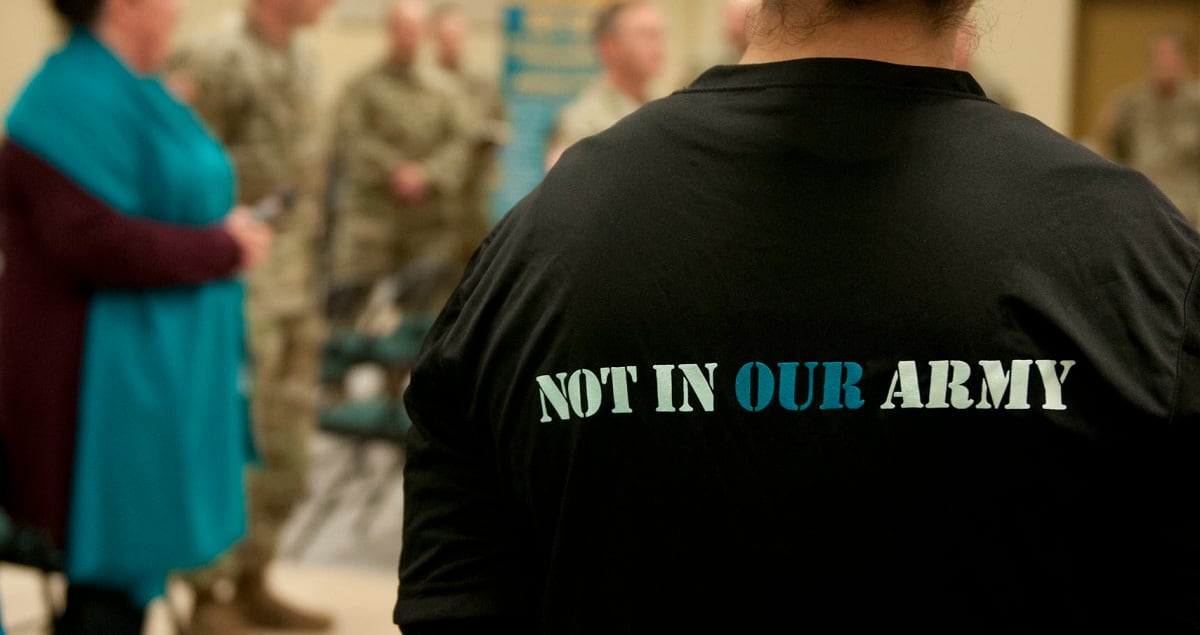Sexual assault prevention training has long focused on male perpetrators and female victims, but knowing that research finds that more men than women are sexually assaulted while serving in the military, the Army is making a pivot toward tackling male-on-male sexual violence.
Central to the effort will be a “male survivor tour," a program conceived of in 2016, that will finally get on the road next year, officials say.
A cornerstone of that effort is a Digital Survivor of Sexual Assault training module, which immerses a student in a conversation with a real soldier. The story and answers are pre-recorded, but the technology is responsive enough that the program can search about 2,000 possible responses and provide the correct one, based on a student’s question.
For now, the soldier in that trainer is former Spc. Jarett Wright, who in 2012 went public with his story of rape and hazing while deployed to Iraq with the 1st Cavalry Division.
“If you’re trying to get someone who’s a proud, masculine man to come forward, the way the information’s presented needs to change,” Wright told Army Times in 2017.
At the time, the Army had announced the male survivor tour, as well as a handful of other new initiatives under the Sexual Harassment and Assault Response and Prevention program. It was put on the back-burner during the change of administration, an Army spokesman told Army Times in 2017, but plans are once again in place to make it happen.
“In 2019, we plan to distribute additional portraits, paired with male survivors and/or subject matter experts who will dialogue with audiences about male victimization, the unique characteristics of male sexual violence, and how the Army supports survivors,” Karan Reidenbach, acting director of the SHARP program office, told Army Times in a statement in July.
The Army declined to make SHARP program officials available for interviews.
Wright got involved in the effort in 2016, when officials reached out to him about participating in the Army’s “hologram project," inspired by the University of Southern California’s Shoah Project, which took down the experiences of Holocaust survivors for a similar interactive Q&A.
He had participated in an NCO professional forum at the Association of the U.S. Army’s annual meeting in 2013, then made a video about hazing and sexual assault with the Center for the Army Profession and Ethic in 2014, so he was on the SHARP program’s radar.
The reason for that notoriety stems from a series of incidents in 2010, when Wright and other members of his troop were physically and sexually assaulted by fellow soldiers, with the approval of NCOs and officers, as a “welcome” to the unit.
“On the first day, they ripped me out of my room when I was on Skype with my family, held me face down and then lashed me with a belt 23 times,” as part of a birthday ritual, Wright told Army Times. “And when I got up, the company commander was there, the first sergeant was there, coming to shake my hand — the whole company was out there.”
Then it escalated. It happened to his roommate first, so they started locking their door at night. But the one time they left it unbolted, a group busted in looking for Wright, holding him down on his bed, grabbing his genitals and inserting a finger in his anus.
At first, the guys said nothing, like more than 80 percent of male military sexual assault survivors, according to Defense Department statistics.
When it kept happening to others in the unit, the survivors stepped up ― three of the four soldiers involved were found guilty at court-martial, while the so-called ringleader went free after his charges were dismissed on a technicality. He ended up pleading guilty to lesser charges.
“So, I had to continue to see this guy and get harassed by this guy for months,” Wright said. “I knew he was staying in the Army, and I didn’t want him to do this to someone else when he got promoted back to sergeant eventually.”
“I would have rather went to a full trial than let him — I think he went to the jail cell for like an hour, and then he was released," he said. “And was ending up in the squadron formation with us, running, the next day.”
‘You took away our power’
Wright moved on and left active duty, serving with the Florida National Guard for several years before returning to civilian life to finish college. But his advocacy continues, he said, as a speaker at SHARP events.
"Sometimes I’ll go to places and they’ll be like, ‘I don’t know why you do this. Why are you trying to change the Army? You’re the worst thing that ever happened,' " Wright said. “Someone told me that I was single-handedly destroying the NCO corps, and things like that.”
But not because NCOs support sexual assault, he explained.
“Hazing and discipline policies have changed. They view it as, because you guys were complaining, you took away our power, our authority. Not realizing that there are other methods of instilling discipline in people,” he said. “The people that have been the power-hungry, and have enjoyed being in that dominating position, I guess — they’re not too happy with me.”

But Jarett Wright is only one man, so the Army turned his story into a training tool that can be used on-demand at both the SHARP Academy at Fort Leavenworth, Kansas, and by sexual assault response coordinators and uniformed victim advocates at individual commands.
“The student speaks into a special microphone that puts it into the application, then based on 17 hours of content and the ability to answer over 2,000 questions, it matches the most appropriate response,” Col. Chris Engen, the academy’s director, told Army Times in March. “They have the opportunity to interface with an actual survivor, but without requiring that survivor to continually recount his experience.”
Wright spent roughly 40 hours filming, answering more than 5,000 questions, he said.
“The work that has been done is amazing, and even just watching people interact with the beta version blew my mind with how invested people became in my virtual self,” he said. “Seeing their reactions gave me faith that it will genuinely have the intended effect, and be a great asset to the Army SHARP program, and I hope that it can encourage people to get the help they need.”
But of course, Army SHARP training is not just for leadership. The service has been grappling with how best to reach soldiers since the invention of sexual assault prevention training. The program hasn’t ruled out using the Digital Survivor of Sexual Assault module down to the individual soldiers, but it’s a sensitive proposal, Engen said.
“The reason I say that is, we want to be good stewards — first and foremost — of Jarett’s story,” he said. “We want to use it selectively and with the correct outcome goal.”
Though Wright has not been tapped for the planned survivor tour, he said, he’s seen success in individual speaking events.
“I’ve met many, many people — either victims that I’m speaking with, that I’m good friends with, or people that, after I talk, they’ll wait half an hour to come talk to me,” he said. “We’ll have long conversations about what happened to them, and they’ll end up coming forward and seeking the help they need.”
RELATED

Not just hazing
Speaking from experience, Wright said, the particulars of male-on-male sexual assault ― which often occurs in a hazing context, rather than a romantic one ― need to come through in SHARP training.
"I can tell you, the general consensus in the Army community is, ‘Oh God, I have to go to a SHARP briefing, and I’m just going to be told that I’m a rapist, and I’m a guy, so I’m the worst thing that ever existed,' " he said.
That’s not the way the Army as a whole paints the picture, he added, but the way that a one-size-fits-all training session usually goes.
The vast majority of male survivors don’t come forward, Wright said, and some because they haven’t been trained that those extreme hazing rituals are just as much a rape as anything else.
“There hasn’t been that welcoming environment ― not only command climate, just the way the information is presented," he said.
Changing that culture starts with the way men in a unit talk to each other, a common theme in more recent sexual assault training, which focuses on behavior toward women.
“It has to start with the basic climate of what behaviors we tolerate just in our language, and then people watching the way that they treat each other,” Wright said. “ ‘Oh, I definitely see this behavior going on in my unit. This is what I need to do to stop it.’ ”
Because in the high-testosterone, physically charged environment of the military, he added, it can get out of hand.
“Guys are competitive. We like to one-up each other. We like to humiliate each other, but not in a sinister way,” he said. “But that stuff ends up escalating, to everyone trying to show each other up, do one more.”
For the past several years, Reidenbach said in the statement to Army Times, increasing awareness about male survivors has become more of a priority.
That includes internet and social media campaigns, videos and brochures, she said.
“The more we can create awareness for the male victims, that’s better for the Army,” Engen said. “For male soldiers to see that this in fact does happen — certainly, that’s powerful.”
The numbers
Famously, reports of male sexual assault are drastically lower than they are for female survivors, who still only report about 43 percent of assaults, versus men at 17 percent, according to Army statistics.
But getting men on board is key to not only increasing awareness and reporting, but ultimately prosecution, which has been famously low.
In fiscal year 2017, for example, the Army sent 419 soldiers to court-martial on sexual assault charges, while 198 received non-judicial punishment and 259 received administration action, according to Col. Bill Smoot, chief of the Army’s criminal law division at the Pentagon.
In total, that amounts to some sort of punishment for 75 percent of unrestricted assault reports, down 10 percent from 2013, though it’s necessary to take into account the rise in reporting in recent years.
“As we finalize plans for a Male Survivor Tour in 2019, we are committed to normalizing the conversation, and we continue to develop communication products designed to increase awareness of male victimization and to promote resources for victims,” Reidenbach said.
Meghann Myers is the Pentagon bureau chief at Military Times. She covers operations, policy, personnel, leadership and other issues affecting service members.




